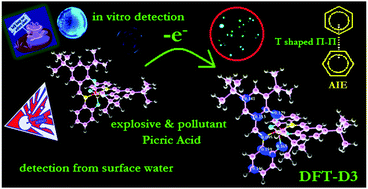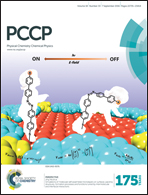How paramagnetic and diamagnetic LMOCs detect picric acid from surface water and the intracellular environment: a combined experimental and DFT-D3 study†‡
Abstract
Diamagnetic and Paramagnetic Luminescent Metal Organic Complexes (LMOCs) have been reported for Explosive and Pollutant Nitro Aromatic (epNAC) recognition. The diamagnetic complex shows a highly intense AIE induced by NEt3H+, which disappears after picric acid recognition and subsequently RET will quench the emission intensity. Radical stabilized paramagnetic LMOCs seem to be active but show lower sensing efficiency in comparison with diamagnetic LMOCs. Solution and solid state spectroscopy studies along with DFT-D3 have been executed to enlighten the host guest interaction. Limit of PA detection is ∼250 ppb with a binding constant of 1.2 × 105 M−1. Time-stepping, i.e. intervening in the problem of picric acid recognition from surface water collected from several places of West Bengal, India, has been performed. Mutagenic picric acid has been successfully detected in an aqueous medium inside both prokaryotic and eukaryotic cells at a ppm level using fluorescence microscopy.


 Please wait while we load your content...
Please wait while we load your content...